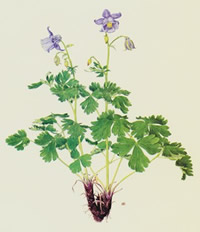Aquilegia nuragica
| Aquilegia nuragica | |
|---|---|

| |
| Scientific classification | |
| Kingdom: | Plantae |
| Clade: | Tracheophytes |
| Clade: | Angiosperms |
| Clade: | Eudicots |
| Order: | Ranunculales |
| Family: | Ranunculaceae |
| Genus: | Aquilegia |
| Species: | A. nuragica
|
| Binomial name | |
| Aquilegia nuragica Arrigoni & E.Nardi
| |
Aquilegia nuragica, commonly called Nuragica columbine, is a perennial species of plant in the family Ranunculaceae. It is endemic to Italy, on the island of Sardinia.[2]
Description[edit]
They have a single vertical stem. Each division creates a set of three stalks. The flowers of this species are pale blue or white, consisting of five fused petals with its end having a hooked spur. [3]
Aquilegia nuragica is only found in one area of about 50 square metres (540 sq ft) at Gorropu, near Urzulei. It grows on the nearly vertical limestone cliffs, in a gorge along the Flumineddu River. It can occasionally be found on the sandy pebble substrate of the riverbed due to seeds being dispersed from the cliff.
Its natural habitat is in Mediterranean shrubby vegetation.
Status[edit]
It is an IUCN Red List Critically Endangered plant species and IUCN Top 50 Campaign Mediterranean Island Plants, threatened by habitat loss. The Aquilegia nuragica population is very small, with only 10-15 individuals that are believed to exist.[2]
Threats[edit]
The decline in the plant's population seems to be due to natural factors, although due to the inaccessibility of the site, it is difficult to research the decline. It is not affected by grazing due to the plant's toxicity.[2]
Conservation[edit]
This species is currently not under any legal protection.
References[edit]
- ^ Camarda, I. (2006). "Aquilegia nuragica". IUCN Red List of Threatened Species. 2006: e.T61672A12520091. doi:10.2305/IUCN.UK.2006.RLTS.T61672A12520091.en. Retrieved 14 November 2021.
- ^ a b c Camarda, I. (2006-01-31). "IUCN Red List of Threatened Species: Aquilegia nuragica". IUCN Red List of Threatened Species. Retrieved 2020-09-05.
- ^ "World Plants". www.worldplants.ca. Retrieved 2020-09-05.
External links[edit]
 Media related to Aquilegia nuragica at Wikimedia Commons
Media related to Aquilegia nuragica at Wikimedia Commons- IUCN - Top 50 Mediterranean Island Plants: Aquilegia nuragica (Nuragica Columbine)

